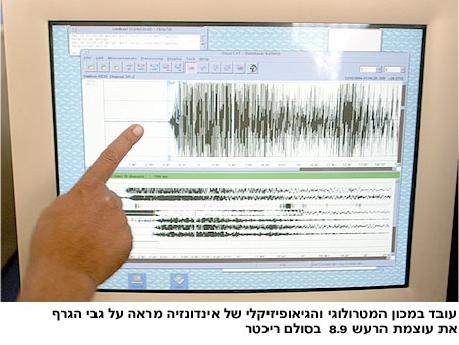An earthquake is a natural disaster that there is no real way to defend against. A person is standing in line at the grocery store, in a traffic jam, sleeping in his bed or at a disco with friends. Suddenly the ground shakes. what can he do?
Yuval Dror

A tsunami can be predicted
An earthquake is a natural disaster that there is no real way to defend against. A person is standing in line at the grocery store, in a traffic jam, sleeping in his bed or at a disco with friends. Suddenly the ground shakes. what can he do? Hold on to the walls? The earth is shaking! run out? The building will fall on him. It is hard to describe a greater feeling of helplessness than this.
The tsunami is a completely different matter. Ed Moretti is an expert on the tsunami phenomenon from the University of Winnipeg in Canada. In an interview with the British "Independent", he said: "No one should die from a tsunami. The appearance of giant waves can be accurately predicted. We have detailed maps that tell us exactly how long it takes for a tsunami wave to cross the Indian Ocean." Considering the fact that the earthquake that occurred at the beginning of the week caused the death of tens of thousands of people, one can only state that this is the most irritating statement of the week.
There was a warning
The tsunami moves at the speed of a jet plane: 1,000-600 kilometers per hour. However, even at this speed, two hours passed from the moment the earthquake occurred until the waves reached the shores of Sri Lanka. Another hour passed before the waves reached India and another three hours before they reached the eastern shores of Africa. Despite this, tens of thousands of people died without anyone warning them that the ocean was about to overflow.
Here is another boiling statement. Jeff Lahdos from the American Maritime Institute told in an interview with "USA Today" that 20 minutes after they realized the magnitude of the earthquake, the institute issued a flash. The problem is, there was no one to inform. Lahdos even sent a panicked e-mail to his colleagues in Indonesia, but so far it is not known what happened to it.
However, even if some warning had been received, it is not at all clear if it would have been possible to evacuate such large populations in more than 10 countries and in such a short period of time. Experts further claim that it is not enough just to have a warning system, but there is also a need to educate the public on how to act in the event that such a warning is indeed given.
The sea loves the poor
On the other hand, it is difficult to point a finger of blame towards the developing countries such as Sri Lanka, Indonesia, Thailand, India and others. Studies carried out in the mid-90s found that for every one death as a result of a natural disaster in the developed countries, there are 15 deaths in the developing countries. While severe earthquakes cause tolerable damage and a limited number of deaths (if any) in areas such as Los Angeles and various prefectures of Japan, earthquakes of the same intensity that occur in developing countries, cause the death of tens of thousands. The recent earthquake that occurred in Iran and claimed more than 30 thousand victims, is just one example of this.
Unlike the western world, where only the rich can afford a house with a sea view, in Southeast Asia, it is the poor who live on the beaches. They are unable to pay for the living conditions required of the residents inside the country. They are the first to suffer Poseidon's wrath.
The default of the tsunamimeters
The developed countries invest considerable resources in prevention, warning and advanced technologies designed to prevent victims when a natural disaster occurs. A system of six tsunamimeters, sophisticated underwater sensors whose job it is to warn of the tsunami waves that might flood Hawaii, are spread out in the Pacific Ocean. Off the coast of Japan are spread 14 similar sensors that transmit in a fraction of a second information about seismic activity to a supercomputer of the Meteorological Agency that calculates the speed, power and destination of each tsunami on its way. Within two minutes, the agency can activate alarms and warnings throughout the country.
However, this system is not immune to failures. Thus, for example, according to a NASA website dedicated to tsunamis, three warnings out of four issued since 1948 were wrong; And the price of a false alarm may be high. A large population evacuation in Hawaii could cost about $70 million in terms of lost economic output, according to the US Oceanic and Atmospheric Administration. Since the 60s, said Dr. Laura Kong - a seismologist at the US Department of Commerce and director of the International Tsunami Information Center, which operates on behalf of the United Nations in Honolulu - there have been two warnings in Hawaii that led to the evacuation of citizens, and which ultimately turned out to be false warnings.
Each cubic meter costs 250 dollars and the annual cost of holding it is about 50 dollars. In the past there was a plan to place 3-2 such devices in the Indian Ocean, one of which was supposed to be located near Indonesia. The plan never came to fruition.
Senior officials in the affected countries admit: we could have prevented the disaster but we have no money. Others claim that even if they had the money, they would not have invested in this warning system, because tsunamis are common in the Pacific Ocean but rare in the Indian Ocean. Politics of oceans.
The trap closes
There is something about the forces of nature that leaves humans speechless. A tornado, for example, is a stunning phenomenon in its power, in its perfect geometric appearance, in the path of destruction it leaves behind. The tsunami is no different in this sense. It's a fascinating natural phenomenon, a perfect death trap.
Sometimes the structure of the beach is such that when a tsunami hits, it draws the water from the beach, as if sucking it with a straw. Suddenly people notice that what was a moment ago a calm bay has turned into a filthy muddy bottom with frightened fish fluttering about. They come over to see, it's intriguing. This is when the trap closes; The ocean empties its lungs and spits back the water with tremendous force.
A train of waves
A tsunami is not a single giant wave; He is a train of waves. The first wave is not necessarily the biggest or most destructive wave. The length of a tsunami wave can reach about 100 kilometers and five minutes to an hour may separate one giant wave from another. Although it is formed in the depths of the ocean, it loses almost no energy on the way. The height of a tsunami wave moving in the middle of the sea can be dwarf: about 60 centimeters in total. This fact makes his identification from an airplane a futile task.
Online lifeline
After the terrorist attack of September 11, the phenomenon of blogs (internet diaries) grew. Family members and your people America, asked to share their feelings with their network friends. Since then, the "blogosphere" has grown and developed. During the Iraq war, the first opportunity to prove itself arose. The US presidential election was the second chance. Now the third opportunity appeared.
The blog writers (bloggers) provided live reports accompanied by pictures (this is how it is when everyone has a digital camera) and interpretation of the events. These were heartbreaking, shocking, authentic reports of the kind that are rare to read from journalists who go from disaster to disaster.
The internet was also used by family members looking for their loved ones. In Israel, parents and friends flocked to the forums, where connections were made between family members of travelers who traveled in the same area. The web has become a lifeline of information. This is how the Internet managed to perform two actions at the same time: challenge the status of the traditional means of communication, and turn itself into an effective means of communication that everyone is waiting for.

